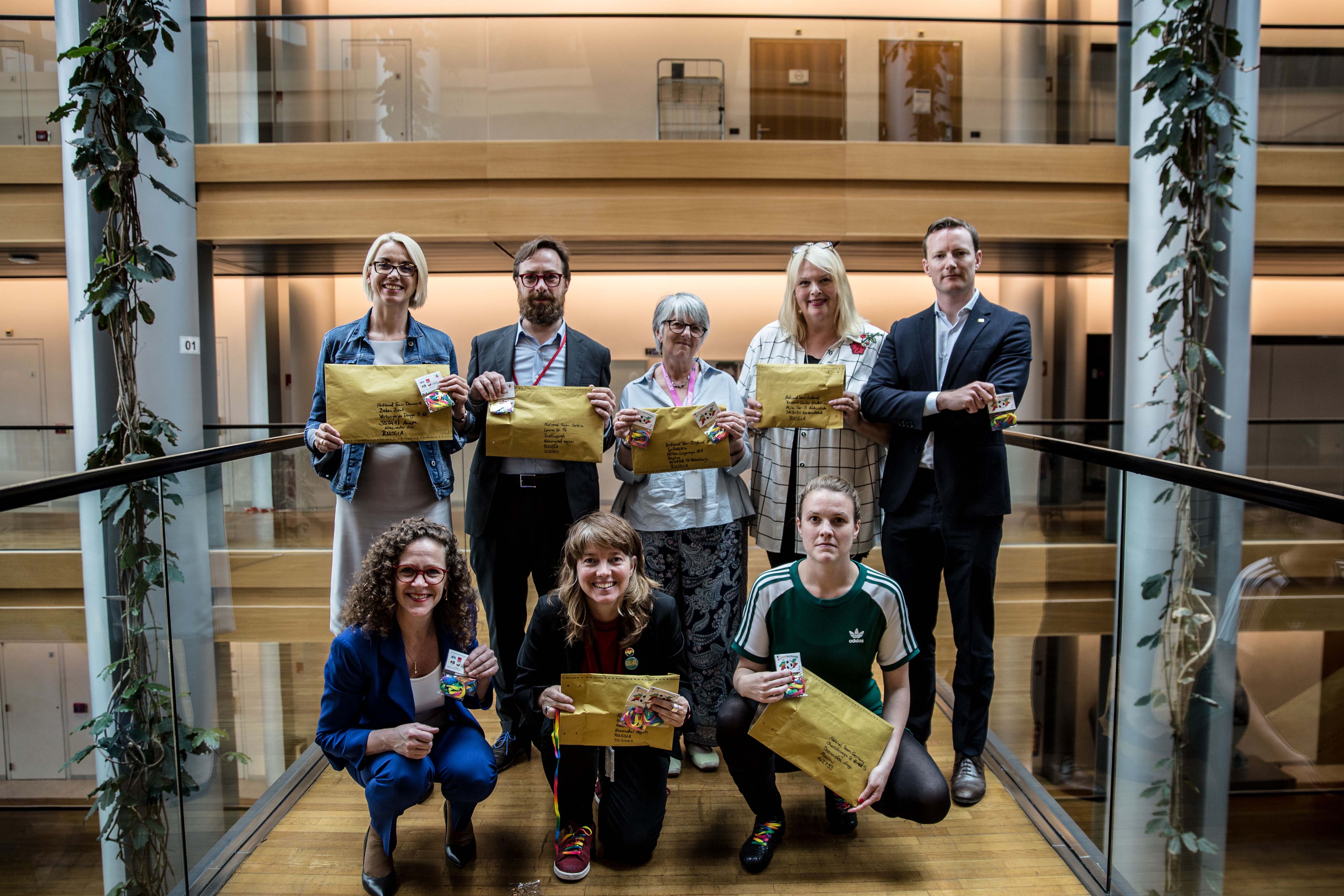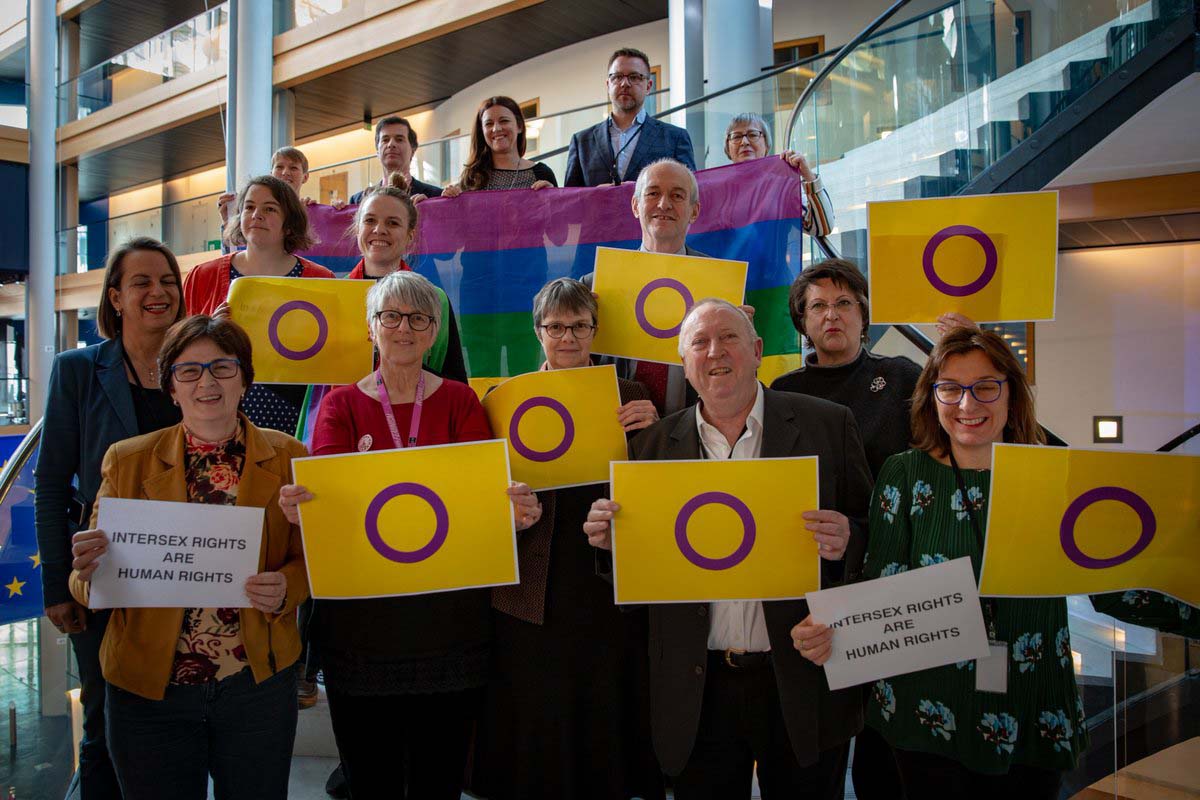European Parliament hosts Walk With Pride exhibition
On the occasion of the International Day Against Homophobia (17 May), the European Parliament will host a selection of pictures from the global photo exhibition Walk With Pride from 9 to 12 May 2011. Members of the European Parliament, staff and press will see the exhibition displayed at the seat of the European Parliament in Strasbourg.
 The exhibition will be formally opened by Jerzy Buzek, President of the European Parliament, on Tuesday 10 May.
The exhibition will be formally opened by Jerzy Buzek, President of the European Parliament, on Tuesday 10 May.
These images were taken by award-winning photographer Charles Meacham during the 2010 pride season, and showcase 11 different prides in Europe. The exhibition, a global initiative of the International Day Against Homophobia Committee, reveals the diversity of pride as well as the extent homophobia can manifest itself within societies.
The Walk With Pride exhibition will be shown in over 20 locations around the world in 2011, starting with an opening at the European Parliament from 9 to 12 May.
Freedom of expression
Vilnius, Lithuania – Young Lithuanians hold up the rainbow flag and display the message “Welcome to gay Vilnius” during the 2010 Baltic Pride, Lithuania’s first ever pride march. Important political manoeuvring took place to prevent the march from taking place, with Members of Parliament and local officials seeking to suspend the authorisation first granted by the Mayor. The Administrative High Court lifted the permit suspension just one day before the march. Around 350 participants took part in the historic event, protected by 800 policemen and women.
Athens, Greece – A woman holds up an Orthodox icon among pride marchers and rainbow flags. Only one single religious protestor showed up at Athens Pride 2010. In all the prides we visited, participants and activists always met counter- protestors with humor. We never once came across an LGBT organization that said people shouldn’t have the right to hold counter-protests.
Religion
Vilnius, Lithuania – Two believers watch on as the Baltic Pride unfolds across the Neris River, a wide stream keeping the two groups apart physically and politically. The Baltic Pride was met with strong opposition, and some Church leaders argued it would subvert societal and family values. In the end, it took place peacefully but for Kazimieras Uoka and Petras Gražulis, two Members of Parliament who broke police cordons and threatened marchers in the secured area.
Bucharest, Romania – Reverend Diane Fisher, a pastor in the global Metropolitan Community Church, walks with activists at the Bucharest Gay Fest Pride March. Not all denominations send negative messages to lesbian, gay, bisexual and transgender people. For a growing number of Church leaders and believers, religious texts and teachings embrace diversity, regardless of people’s sexual orientation and gender identity.
Right-wing extremist groups
Vilnius, Lithuania – A neo-Nazi leader shouts menacing slogans in a megaphone next to police cordons at Baltic Pride. Although it is illegal to display a swastika in Lithuania, the police would not take away the group’s flags stating that minor changes made it legal.
Zagreb, Croatia – Young protestors give the Nazi salute or otherwise express their discontentment as the pride passes. Some violent protestors were arrested during the pride, and several participants were physically assaulted after the event. However, when news channels showed a police officer kicking one of the protestors in the head during an arrest, pride organizers showed nothing but concern for the young man.
“Family value” groups
Bucharest, Romania – A young mother and her baby look on at a rally organized by a group claiming to represent “family values”, the day before the pride. While the pride was not allowed to march down the crowded streets of the city centre, an organization using hate speech around young children was granted permits to demonstrate in the busiest parts of the city.
Bucharest, Romania – A hateful flyer promises LGBT people that they will go to hell. My fiancée and I were handed this flyer by a young boy as we walked back to our hostel from the pride. His parents had given him these flyers, and told him to give them to anyone passing by. Hate groups increasingly invite women, families and children to relay their messages, hoping this will make discrimination look more acceptable and sensible.
Facing the public
Sofia, Bulgaria – A few days before the pride march, two organizers of Sofia Pride (back) debate live with a representative from a “family values” group (front) on public radio. The representative of the anti-gay group made hateful statements on air, including that all homosexuals are prostitutes, sell drugs, and are infected with HIV. Had the pride representatives not been on the radio, these messages would have remained unchallenged.
Zagreb, Croatia – Policemen in riot gear protect pride participants in the Croatian capital. Hundreds of anti-riot police were needed to keep the piece during the 2010 Zagreb Pride. One of the arguments against having prides is that the costs incurred by municipal authorities can be extremely high to ensure marchers’ security. Many times, it is the participants of prides who are blamed for these costs, instead of the violent protest groups that create the need for heightened security.
Police education
Istanbul, Turkey – Bilge, a young transgender woman, exhibits bruises from a physical attack shortly before Istanbul Pride. We gave her this photograph so it could be used as evidence in court. When she went to the police stations they laughed at her and refused helping, until a lawyer got involved. It’s important to educate police forces for the protection of LGBT people, and that they are held accountable when not following procedure. Repeated violence against transgender people in Turkey led to organizing Istanbul’s first Trans Pride in 2010.
Minsk, Belarus – Sergey Yenin, a Belarussian activist, stands alone in the office of Gay Belarus. “Here, we hope the police detain us before the homophobes come.” Sergey and a number of other participants were arrested and held for several days under harsh conditions for participating in Slavic Pride. Upon his release he sent me this email:
I was released today in the afternoon. Now I’m kinda safe and sound, but i’m covered with bruises and bleeding deep scratches all over. the policemen used to beat and mock at me. I spent 2 days in an isolator for administrative criminals. I can’t recall this time without tears in my eyes.
The importance of public figures
Sofia, Bulgaria – Member of the European Parliament Michael Cashman holds a flag of the European Union, while Sofia Pride organizers discuss just before heading to the march. Local authorities and national governments are under more pressure to protect pride participants when public figures, such as Members of the European Parliament, take part. In 2010, Members of the European Parliament attended pride marches and helped ensure heightened security in Poland, Malta, Lithuania, Slovakia, Bulgaria, Romania, Moldova and Serbia.
Warsaw, Poland – Russian activist Nikolai Alekseev and German Green MP Volker Beck walk together during the EuroPride 2010 in Warsaw. A member of the Bundestag since 1994, Volker Beck has marched in every Moscow Pride despite being physically assaulted and shortly arrested at the march in 2006. Elected officials taking part in pride marches help to ensure the events receive greater attention from the media and heightened protection by police forces.
LGBT history in the making
Budapest, Hungary – Two friends hold each other in the Kerepesi cemetery, in the outskirts of the Hungarian capital. Every year, a small memorial is held at the grave of Károly Mária Kertbeny, the Hungarian writer who coined the terms ‘homosexual’ and ‘heterosexual’ in 1869. A few months after this image was taken, his grave was vandalized with homophobic inscriptions.
Budapest, Hungary – A large boulevard in the outer limits of Budapest’s city centre, as the pride parade unfolds. Started in 1992, the history of Budapest Pride goes back almost two decades. While it is more common for social acceptance to increase as prides are held for longer, homophobic protestors in Budapest have successfully used violent attacks to decrease Budapest Pride’s visibility. Since the heavy attacks on the pride in 2007 and 2008, the march now takes place on a closed-off and empty street, out of public view. While this does keep participants away from violent protestors, the general public can be unaware that a pride is even happening.
The rainbow flag: a powerful symbol
Moscow, Russia – Marie Yefremenkova, co- organizer of Saint Petersburg Pride, gathers strength before heading out to march in Moscow. In 2010 Moscow Pride was banned for the eighth year in a row, but activists staged a spontaneous event which surprised authorities. This required heavy coordination and secretive meetings at undisclosed locations.
London, United Kingdom – Young activists rest in central London after the London Pride took place in the very city centre, a long rainbow flag waiting to be folded on the pavement. There is a stark contrast between this flag left on the ground for half an hour after the pride finished, whilst it got burned in Lithuania, hidden in Russia, confiscated in Belarus and ripped down in Poland for the rights it represents.
State-sponsored homophobia
Bucharest, Romania – A young woman flies the rainbow flag in front of the Romanian Parliament. This is a freedom she would not have enjoyed just a generation ago. Romanian authorities recently made efforts to safeguard the right to freedom of expression and assembly for LGBT people. A lot of these positive changes were brought about by Romania’s accession to the European Union in 2007.
Moscow, Russia – Activist Nikolai Alekseev sits in the waiting area of a courtroom ahead of a hearing on the ban of Moscow Pride, while the city’s lawyer looks on. Nikolai has lead the fight for LGBT marches in Russia for many years. In October 2010 the European Court of Human Rights ruled that Russian authorities had no right to ban the pride march, as it had done for the last 7 years. Russia’s appeal was turned down in April 2011. Following the Strasbourg ruling, Nikolai has applied for authorization to hold a pride march in May 2011, which I plan to again photograph. He says activists plan to march regardless of whether or not city authorities grant the authorization.
Pictures of the inauguration will be posted as soon as they become available.


























